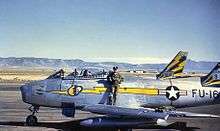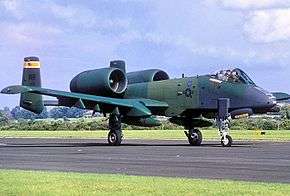92d Information Operations Squadron
| 92nd Information Operations Squadron | |
|---|---|
|
| |
| Active | 1942–1945; 1946–1993; 2000–present |
| Country |
|
| Branch |
|
| Role | Information Warfare |
| Engagements |
Mediterranean Theater of Operations China-Burma-India Theater |
| Insignia | |
| 92d Information Operations Squadron emblem (approved 30 June 1945[1] |
|
The 92d Information Operations Squadron is a United States Air Force unit. + It was formerly a fighter unit. Its last assignment as a fighter unit was with the 81st Tactical Fighter Wing at RAF Bentwaters, England, where it was inactivated on 31 March 1993.
History
World War II
The squadron was activated in early 1942[1] under III Fighter Command in North Carolina. Initially trained with Bell P-39 Airacobras, re-equipped with Lockheed P-38 Lightnings.
Moved overseas, October 1942 – February 1943,[1] the ground echelon arriving in French Morocco with the force that invaded North Africa on 8 November, and the air echelon, which had trained for a time in England, arriving in North Africa between late December 1942 and early February 1943.
Began combat with Twelfth Air Force in January 1943. Supported ground operations during the Allied drive against Axis forces in Tunisia. Patrolled the coast of North Africa and protected Allied shipping in the Mediterranean Sea, April–July 1943. Provided cover for the convoys that landed troops on Pantelleria on 11 June and on Sicily on 10 July 1943. Supported the landings at Anzio on 22 January 1944 and flew patrols in that area for a short time.
Transferred to the China-Burma-India Theater and moved to India, February–March 1944. Initially performed training with Curtiss P-40 Warhawk and Republic P-47 Thunderbolt aircraft. Moved to China in May and became part of Fourteenth Air Force. Continued training and on occasion flew patrol and escort missions before returning to full-time combat duty in January 1945. Attacked enemy airfields and installations, flew escort missions, and aided the operations of Chinese ground forces by attacking troop concentrations, ammunition dumps, lines of communications, and other targets to hinder Japanese efforts to move men and materiel to the front.
Inactivated in China on 27 December 1945.[1]
Cold War

Reactivated at Wheeler Field, Hawaii in late 1946.[1] Equipped with North American P-51 Mustangs and performed air defence of the Hawaiian Islands until 1949. Was reassigned to Continental Air Command Ninth Air Force, being stationed in New Mexico. Re-equipped with Lockheed F-80 Shooting Star jet aircraft, trained as a tactical fighter squadron. Upgraded to North American F-86 Sabres in 1950.
Reassigned to Air Defense Command, becoming part of the Western Air Defense Force, being moved to Moses Lake Air Force Base, Washington. In Washington the squadron's mission was the air defence of eastern Washington, including the Grand Coulee Dam and the Hanford Nuclear Reservation.
United States Air Forces in Europe

Ordered to the United Kingdom in 1951, mission to assist the Royal Air Force in the Air Defense of East Anglia, being assigned to the newly refurbished RAF Bentwaters. Also operated from a dispersed station, RAF Shepherds Grove about forty miles apart.
The squadron was one of the first Sabre Jet unit to be based in Europe, and the first to form an integral part of the peacetime air defense of Great Britain. In this role, the squadron came under the operational control of the RAF Fighter Command No. 11 Group during the actual defense of the United Kingdom, and for combined operational training. Under USAFE, the squadron came under the control of Third Air Force which coordinated its activities with the RAF.
In October 1954 the mission of the squadron changed from fighter-interceptor to fighter-bomber operations, carrying both conventional and nuclear weapons. The squadron was charged with tactical operations in support of USAFE and NATO, with air defence as a secondary mission. To reflect this change, the unit traded in its F-86s for the F-84F Thunderstreak.

Beginning in the fall of 1958, the squadron was re-equipped with the McDonnell F-101 Voodoo. The F-101 was configured as a fighter bomber, intended to carry a single nuclear weapon for use against battlefield targets such as airfields. The Voodos were equipped with Low Angle Drogued Delivery and Low Altitude Bombing System equipment for its primary mission of delivering nuclear weapons at extremely low altitudes. Pilots were trained for one-way missions into Soviet territory to increase effective range at some cost in negating pilot recovery.
In November 1965, the squadron received McDonnell F-4 Phantom II to replace the Voodoos. Initially receiving the F-4C this was later upgraded to the more capable F-4D during late 1972 and 1973. Began conversion to the Fairchild Republic A-10 Thunderbolt II]] in June 1979. The A-10 being a single-seat, twin-engine jet aircraft designed to provide close air support of ground forces by attacking tanks, armored vehicles, and other ground targets. With the A-10, the squadron's mission changed to close air support and battlefield air interdiction in support of NATO ground forces.
With the end of the Cold War in 1991, the USAF presence at Bentwaters was gradually phased down. It was announced that the base would be closed and the squadron would be inactivated. Squadron was inactivated on 31 March 1993.
Information warfate
The squadron became the 92d Information Warfare Aggressor Squadron and was activated at Kelly Air Force Base, Texas in November 2000. As the 92d Cyberspace Operations Squadron, the unit operates the Cyberspace Vulnerability Assessment/Hunter Weapon System, which is designed to "find, fix, track, target, engage and assess advanced persistent threats" to missions on the Air Force Information Network.[2]
Lineage
- Constituted as the 92nd Pursuit Squadron (Interceptor) on 13 January 1942
- Activated on 9 February 1942
- Redesignated 92nd Fighter Squadron on 15 May 1942
- Inactivated on 27 December 1945
- Activated on 15 October 1946
- Redesignated: 92nd Fighter-Interceptor Squadron on 20 January 1950
- Redesignated: 92nd Fighter-Bomber Squadron on 1 April 1954
- Redesignated: 92nd Tactical Fighter Squadron on 8 July 1958[1]
- Inactivated on 31 March 1993
- Redesignated 92d Information Warfare Aggressor Squadron
- Activated on 1 November 2000
- Redesignated 92d Information Operations Squadron on 1 November 2006
- Redesignated 92d Cyberspace Operations Squadron c. 1 December 2015[3]
Assignments
- 81st Pursuit Group (later 81st Fighter Group), 9 February 1942 – 8 December 1945
- 81st Fighter Group later 81st Fighter-Interceptor Group), 15 October 1946 (attached to 81st Fighter-Bomber Wing after 22 April 1954)
- 81st Fighter-Bomber Wing (later 81st Tactical Fighter) Wing), 8 February 1955[1] – 31 March 1993
- 318th Information Operations Group, 1 November 2000 – present
Stations
|
|
Aircraft
|
|
References
- Notes
- ↑ Aircraft is A-10A serial 81-992.
- Citations
- 1 2 3 4 5 6 7 8 9 Maurer, Combat Squadrons, p. 310
- ↑ "Second cyberspace weapon system reaches Full Operational Capability status". Air Force Space Command Public Affairs. February 26, 2016. Retrieved October 6, 2016.
- ↑ Corrin, Amber (December 3, 2015). "Air Force reorganizing to integrate cyber". C4ISRnet. Retrieved October 6, 2016.
Bibliography
![]() This article incorporates public domain material from the Air Force Historical Research Agency website http://www.afhra.af.mil/.
This article incorporates public domain material from the Air Force Historical Research Agency website http://www.afhra.af.mil/.
- Maurer, Maurer, ed. (1983) [1961]. Air Force Combat Units of World War II (PDF) (reprint ed.). Washington, DC: Office of Air Force History. ISBN 0-912799-02-1. LCCN 61060979.
- Maurer, Maurer, ed. (1982) [1969]. Combat Squadrons of the Air Force, World War II (PDF) (reprint ed.). Washington, DC: Office of Air Force History. ISBN 0-405-12194-6. LCCN 70605402. OCLC 72556.
- Cornett, Lloyd H; Johnson, Mildred W (1980). A Handbook of Aerospace Defense Organization, 1946 - 1980 (PDF). Peterson AFB, CO: Office of History, Aerospace Defense Center. Retrieved March 23, 2012.
- "ADCOM's Fighter Interceptor Squadrons". The Interceptor. Aerospace Defense Command. 21 (1): 5–11, 26–31, 40–45, 54–59. January 1979.
External links
- Osborne, Capt Casey (June 26, 2012). "The Skulls of the 92nd: Defending the front lines of cyber warfare". Twenty-Fourth Air Force Public Affairs. Retrieved October 6, 2016.
- Skinner, BG Robert J. (December 2014). "The Importance Of Designating Cyberspace Weapon System". MilSatMagazine. Retrieved October 6, 2016.
- "Air Force Command Realigns Cyberspace Capabilities". infosec Island. May 18, 2012. Retrieved October 6, 2016.


.jpg)